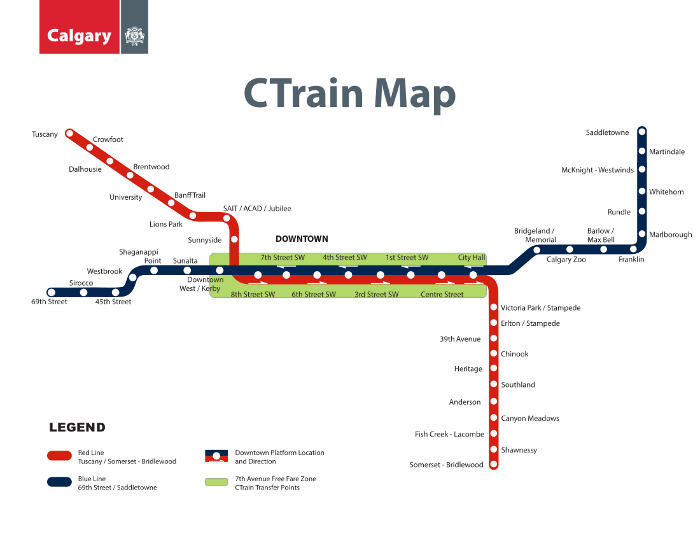Calgary is an important city of the province of Alberta in Canada. It has a light rail system, which is also known as the C-Train. It is estimated that this light rail system transports over 333.800 users per day.
The Calgary light rail system is comprised of two lines and a total of 45 stations. It offers service throughout a 59.9 kilometer-long network.
This massive transportation system offers service for 20 hours straight, beginning at 4:00 am and ending at 1:00 am. It has an average train frequency of 10 minutes, but it changes depending of the time and how crowded the trains are.
It has a unique fare system. A single ticket for an adult costs 3.30 Canadian dollars (CAD,) while the same ticket costs 2.30 CAD for young people between 6 and 17 years of age. Also, the system offers passes which can last for a day or for a month.
The Calgary train offers you the possibility of travelling to and from the Calgary International Airport through three bus routes that are owned by the firm Calgary Transit.
Metros in Canada: Calgary C-Train
The Calgary train history started on 1909, when the tramway service began operations. During that time the city had 12 tramways that covered a network of 25.7 kilometers of railroad, which benefited an average of 30,000 passengers.
Afterwards, on 1932, the city acquired natural gas buses. This helped the users that lived far away from the tramway stations to have transportation.
Throughout the decade of the 40s, the transportation system was gradually modernized. As a consequence, tramways were being eliminated and replaced with a more flexible system. This included the use of buses and electric trolleys. As a fun fact, the last tramway on the city is being exhibited at Heritage Park since 1950.
The population of Calgary had a spike in growth between 1950 and 1975. It is estimated that the population grew to have almost half a million new inhabitants. Therefore, the city’s transportation system needed an expansion to cover the growing transportation demand.
This way, during the late 60s and the early 70s, new buses with diesel engines were acquired, which were chosen since they were relatively cheap, offering much more flexibility on the routes.
It wasn’t until 1967 that the idea of building metro system was considered. The metro would have two lines and, in 1970, the decision of building a light rail metro system was made.
On 1978, after almost 11 years later, the construction of the C-Train system began. The first line was built between Anderson Road and 7th Avenue, and had a total length of 10.9 kilometers.
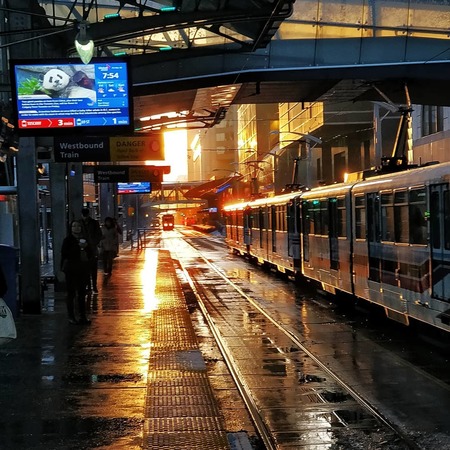 Calgary C-Train
Calgary C-Train
The northeastern line opened its doors to the public on April, 1987. Meanwhile, the western line started operations on December, 2012.
Lines and stations
The lines of the Calgary train are called lines 201 and 202 respectively. The first line’s signature color is red, and the second line’s signature color is blue. Some of the routes are located underground, while others are located at surface-level, and the rest of the stations are elevated.
The C-Train has a 2 kilometer-long route, and it’s located on downtown Calgary, which is now known as “the Transit Mall.”
Line 201. The red line:
This line goes between the northwestern sectors of the city to the southern part of the city. It is comprised of two branches, the northeastern branch and the southern branch. Both branches join together at the Transit Mall. This line has an extension of 33 kilometers, and it has 20 stations.
- Color of the line: Red.
- Number of the line: 201.
- Name of the line: Tuscany – Somerset – Bridlewood.
- Number of stations: 20.
- Length of the line: 33 kilometers.
- Time that it takes to travel from one end of the line to the other: xx.
- Schedule: Between 4:00 am and 1:00 am.
Stations: Tuscany, Crowfoot, Dalhousie, Brentwood, University, Ban Trail, Lions Park, SAIT/ACAD/Jubilee, Sunnyside, Victoria Park/Stampede, Erlton/Stampede, 39 Avenue, Chinook, Heritage, Southland, Anderson, Canyon Meadows , Fish Creek - Lacombe , Shawnessy, Somerset – Bridlewood
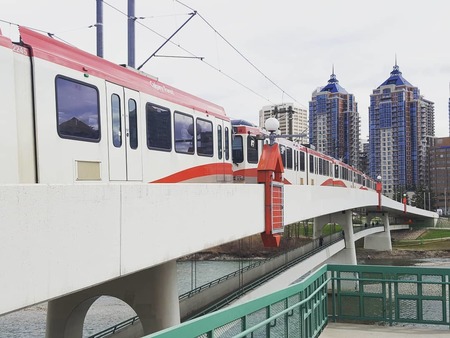
Line 202. The blue line:
The second line goes from the northeastern sector of the city to the western sector. It also goes towards the Transit Mall, in which the two parts of this line join together. This line has 17 stations, and it has a length of 25.7 kilometers.
- Color of the line: Blue.
- Number of the line: 202.
- Name of the line: 69 Street – Saddletowne
- Number of stations: 17
- Length of the line: 25.7 kilometers.
- Time to travel from one end of the line to the other: xx.
- Schedule: Between 4:00 am and 1:00 am.
Stations: 69 Street, Sirocco , 45 Street , Westbrook , Shaganappi Point , Sunalta, Downtown West/Kerby, Bridgeland/Memorial , Zoo, Barlow/Max Bell, Franklin, Marlborough, Rundle, Whitehorn, McKnight – Westwinds, Martindale, Saddletowne
Schedule and train frequency
The schedule of the C-Train transportation system begins at 4:00 am and ends at 1:00 am. The train frequency during morning peak hours is between four and 7 minutes. The frequency changes to 10 minutes at noon and during the afternoon peak hours, and then it changes to 15 minutes at night.
On Saturdays and Sundays, the train frequency varies between 10 and 15 minutes both during the day and at night, depending on the number of passengers.
Connections
Connections among lines:
Line 201 (the Red line) connects to line 202 8 (the Blue line) between the northeast and the south at the stations of 8 Street, 6 Street, 3 Street, and Centre Street.
Then, on the route that goes between the northeast and the northwest, the lines connect at the stations of City Hall, 1 Street, 4 Street, and 7 Street.
All of these stations comprise the Transit Mall, and they are located at a duty-free zone. This means that you can travel for free and go shopping throughout this entire area.
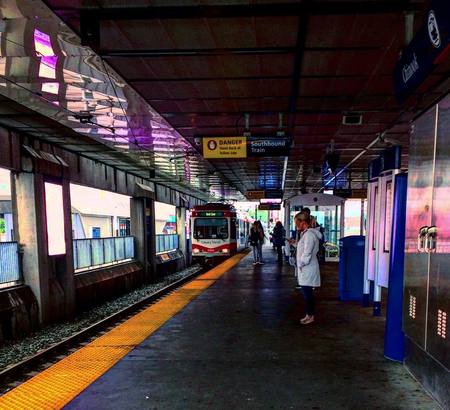
Connections with other systems:
To connect to the Calgary International Airport, passengers have Route 300 at their disposal, which is available at City Hall station. They also have Route 100, which is available at the stations of McKnight – Westwinds and North Pointe.
Currently, there are works being done to the system to make it easier for the users to make transfers to other transportation systems such as:
Airdrie ICE: This is a transportation service that connects Calgary with Airdrie. Even though it has some shared stations with the metro, the fares for each service are different.
On-It: Service that offers rides to passengers from Okotoks, Black Diamond, Turner Valley and High River towards the Bridlewood light rail station at Somerset. This service is available from Monday to Friday during peak hours.
Prices, tickets, and passes
Tickets can be bought in advance, and they can be bought either individually or by packs of 10. They can be bought at a ticket booth or at vending machines located at the stations.
Individual tickets are valid for only 90 minutes, and they allow you to transfer to a bus. The tickets that are bought in advance should be validated at the station before boarding the metro or bus.
The fare for people that are over 18 years of age is of 3.30 Canadian dollars (CAD,) while the pack of 10 tickets costs 33 CAD.
Young people between the ages of 6 and 17 pay 2.30 CAD for a ticket, and 23 CAD for the 10-ticket pack.
Children under 5 years of age travel for free.
Passes:
The system also offers daily and monthly passes, which are available for young people, adults, and seniors. The daily pass, just as its name implies, is only valid for a day, while the monthly pass lasts for a calendar month. The advantage of the passes are that they allow you to have unlimited rides throughout the entire Calgary transportation network.
The daily pass for adults has a price of 10.50 CAD, while the monthly pass has a price of 103 CAD. For young people, the fare for the daily pass is of 7.50 CAD, while the fare for the monthly pass is of 70 CAD.
There are also reduced fares for people of low income and higher education students. These people should be enrolled in the government welfare programs or in special programs at the main universities.
All of the tickets and passes can be acquired at the system´s stations, at the customer service offices, in some stores and supermarkets, in the online store and at vending machines. The vending machines accept coins, debit and credit cards.
Parking on the metro
In most of the C-Train stations, parking services are offered. There are both free parking and reserved parking services.
 Parking in Calgary C-Train
Parking in Calgary C-Train
If a user has many vehicles, including motorcycles, they can register up to five on the system. However, they can only park one at a time at the parking spot.
The reserved parking place is available between 2:00 am and 10:00 am during weekdays. The parking spots that remain vacant after 10:00 am and during the weekends are free.
The users can reserve a parking spot for many months and pay them in advance.
The parking service also allows you to park bikes. Most stations of the C-Train have bike racks in which the users can lock their bikes.
If you want more safety while parking your bike, there is a locker system for bikes at 14 stations. These lockers can be rented for a minimum of six months, and a maximum of one year.
Rules, tips, and advice
- Bicycles are welcome on the metro, but they are not allowed during peak hours, which are from 6:30 am and 9:00 am and from 3:00 pm and 6:00 pm during weekdays. However, if you have a folding bicycle, you can enter with it.
- The seats closer to the entrances are for people with disabilities and senior citizens. Therefore, leave these seats for them.
- It is considered good manners to not to rest your feet on the seats. On the metro, you are obligated to not to put your feet on the seats, or else you will be fined.
- If you use personal audio devices and mobile phones, keep their volume low and lower your voice if you use your phone.
- Do not litter neither on the wagons nor anywhere. Please keep your trash with you.
- It is prohibited to smoke on the transportation system. Also, if you don’t obey this rule, you will get a fine.
- Pets such as dogs can travel for free, but they should be leashed. Other types of animals must be in cages or kennels.
- Before boarding, please step back and allow other passengers to exit the train first.
- Big bags and oversized luggage could disturb other users. Therefore, take the needed measures to not disturb other passengers. You could put your backpack on the floor, but make sure that other people won’t be able to trip over them.
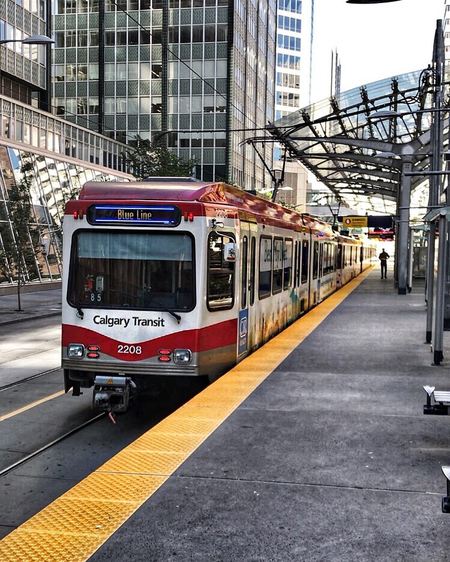 Calgary
Calgary
Fun facts
- A C-Train of three wagons could carry over 600 passengers, which is the equivalent of 545 car rides.
- Using the public transportation system is good for the environment. For instance, the efficiency of a fully occupied bus is six times higher than that of an average car in which only one passenger rides it.
- A single bus can carry as many people as 41 cars. The emissions per passenger and per kilometer produced by the bus are one-fourth than those same emissions produced by cars.
- The buses of the Calgary public transportation service have clean combustion since they use diesel fuel that that has low quantities of high quality sulfur. Also, these buses get maintenance on a regular basis.
- The C-Train is wind-powered. This idea of suing wind power for the metro made the Calgary metro the first system of public transportation to use wind energy in North America. The use of wind energy for the metro removed 56.000 tons of CO2 emissions.
- It is estimated that each kilometer driven by the buses of the massive Calgary transportation service generates 80% less carbon monoxide than a car.
- The C-Train users have many ways of being informed about news and changes on the metro service, which are related to scheduled maintenance or weather, through the Calgary App or through notifications of the C-Train’s Twitter account.
Future expansions
Expansions for the Red line: There are two planned expansions for this line, which will allow the metro to go from the southern part of this branch to Silverado and 210 S. Avenue.
Expansions for the Blue line: There are a series of future stations planned for this line. The plans are to expand the northeastern branch 7.5 kilometers towards 96 Avenue, Country Hills, 128 N. Avenue, and Stoney. Additionally, the western branch will be expanded towards 85 Street.
In this moment, there is no information available about the available funds nor definite construction schedule for the expansion of these two lines.
The new Green line: It is expected that this line will add 28 stations and 46 kilometers of railroad from end to end to the current system. Communities between Keystone and Seton will be connected towards downtown Calgary with this line, which will also have stops available at many points of the blue and red line. It is expected that this line will offer service to 240.000 passengers per day.
The Green line will offer direct connections towards the new Southern Health Campus, the new recreational facilities, the main employment offices, the new National Music Center, the main library, the Rain Park, and many areas of revitalized commercial activity.
The Green line will also be integrated with the future railway service that travels to the Calgary International Airport, where the new international terminal has been recently inaugurated.
Connection to the airport
The Calgary International Airport is located 17 kilometers from downtown Calgary. It is one of the busiest airports in Canada due to its number of passengers. The C-Train allows you to reach the airport, as long as you make a transfer to the city buses.
How to reach the Calgary International Airport
The connection towards and from the Calgary International Airport can be done through route 300 from the City Hall station, and from route 100 from McKnight Station and North Pointe station.
With a fee of 10.50 CAD, you can use the buses and the C-Train all day long to go to the airport. The return trip to the airport is included in that fee as long as you return to the airport within the same day that you arrived.
In the airport, you can take bus at gate 7, which is located to the other side of arrival gate number 2. Also, you could take the bust at gate 32, which is to the other side of the arrival gate number 15.
Passes can be bought at the Mac stores at the airport (which are found close to the arrival gates one and 11.) They can also be bought at the vending machines, located at gate 7 and gate 32.
It is recommended that you have the exact amount when you pay with cash since the store clerks usually don’t have change. You could also pay for your ride from the airport with a valid Monthly Pass. However, you can’t use the Monthly Pass on your return trip to the airport.
Places to sightsee while using the Calgary Metro
You can enjoy art exhibits, concerts, food festivals, sporting events, and many other types of events in Calgary. On the website of the C-Train you could check the most important events of the month. The most emblematic places of the city that you could visit by using the C-Train are:
1) The Calgary Zoo:
It has over a 1000 species of animals from around the world. Also, you could enjoy the following attractions:
- The Prehistoric Park: In it, you can find life-like robots of dinosaurs, such as a T-Rex that starts moving with the press of a button.
- Destination Africa: Here you will find gorillas, colobus monkeys, mandrills, snakes, and crocodiles. If you travel through the savannah, you will find hippos taking a bath, funny giraffes, and lions taking a nap.
- The Penguin: Touristic attraction that has many different species of penguins that dive onto the cold waters of the Antarctic.
- The Canadian Forests: In this exhibit you will find the native fauna, including bears, wolves, pumas, bison, rams and mountain goats.
2) The Aerospace Museum of Calgary.
It’s located to the south of the International Airport. Here, exhibits of over 24 aircrafts and 58 plane engines are shown. Some of these exhibits were part of the “Canadian Museum of the Air”, which ceased to exist on 1971.
In this museum there are also exhibits of the Canadian space program. Also, there is a monument that commemorates the Alberta aviators that died on World War II.
3) Heritage Theme Park
This is a living museum with a surface area of 51 hectares, and it’s located on the southwest of the city. Many historical structures have been brought here from many different parts of the country. However, some of the historical structures in here are replicas.
It has over 180 attractions. Some of these include two steam engine trains which people can ride and travel through the park. Another attraction included is the Commerce Fort of the Hudson Bay firm. Other attractions included are chariots that are pulled by horses, Indian camps, among others.
4) The Core Mall
Famous due to its big size, this mall has over 160 stores and four floors. The most striking feature of the architecture of this big and complex mall is its gigantic glass skylight.
5) Glenbow Museum
It is located on Downtown Calgary. It has the biggest art collection of western Canada.
Also, this museum exhibits important Indian utensils and a great library. This makes it one of the most important centers of investigation of the country.
6) Calgary Tower
With a height of 191 meters, this tower has a 360 degree platform, which allows you to enjoy and excellent view of the entire city.
For those who like taking risks and have an adventurous spirit, there is a glass floor that you can step on so you can see the city below your feet.
7) Downtown hikes.
One way of enjoying the city is by walking. Tourist guides recommend the road between Calgary Tower and Stephen Avenue. Here, you will find bars and restaurants.
Calgary is also famous for its festivals. Some of them are:
Stampede: It’s a festival with thousands of visitors. It lasts 10 whole days. The main attraction is the rodeo. It is celebrated on the month of July. Besides the rodeo, people can also enjoy a big variety of culinary products, parades, and concerts on this event.
Calgary Film Festival: It starts during late September, and ends during early October. Around 200 movies and short films from around the world are shown.
Beerfest: It takes place on May. Visitors have the opportunity to enjoy over 500 types of beer, as well as the local cuisine that is provided by the best restaurants in the city.
Also, the city has parks and gardens, so that people can enjoy being outdoors. Among these parks and gardens are:
Spruce Meadows: Visitors in here can enjoy themselves by having picnics, equestrian activities, taking hikes, and even visiting nearby museums.
Prince’s Island Park: On this park, concerts, cultural and recreational events take place outdoors. Also, people can enjoy nature and just relax on this park.
Metro map of Calgary
Map via www.calgarytransit.comSee map full resolution. It may take a little bit to load.
Download map.
Calgary C-Train map
- Also Known As: C-Train
- Passengers/Day 334000
- Fares:
- 24h operation: No
- Air Conditioning: 0
- Walk between platforms: 0
- Driverless trains: 0
- Screen Doors Platforms: 0
- Operator:
- free/$3.15
- Calgary Metro Official Website
- Tlf: 403-262-1000 / 403-537-7777
Help us
If you consider that the information we provide is wrong, not accurated, outdated, translation contains errors, and you would like to help us to improve the file...you can contact us here.
Feel free to contact us if you dont find the system you're looking for and we'll add it as soon as we can!
Thank you very much!








